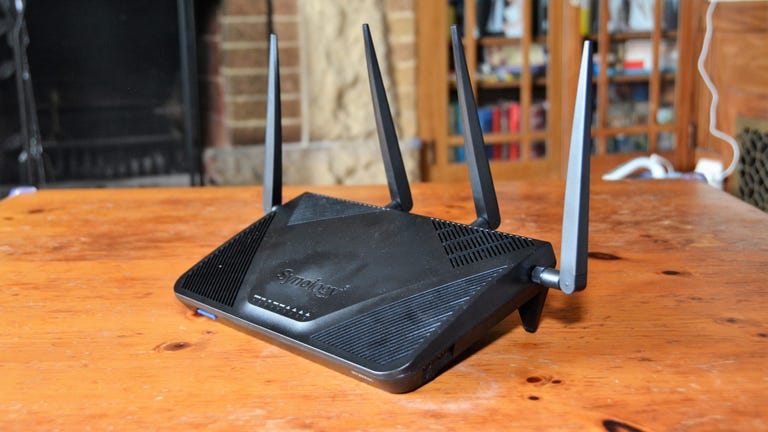 Why You Can Trust CNET
Why You Can Trust CNET Synology RT2600ac review: The best router any savvy user could ask for
The Synology RT2600ac might be the best thing that's ever happened to home networking geeks. Here's CNET's full review.
Synology's RT2600 wireless router is a major upgrade to last year's RT1900AC. At the suggested price of $230 (currently you might have to pay a bit more on the street,) the new model is about $80 more expensive than its older brother but it's totally worth the cost. That price converts roughly to £185 in the UK and AU$300 in Australia. Not only is the RT2600 one of the fastest Wi-Fi routers on the market, it also has the most comprehensive set of features. And when you connect an external hard drive, the router also works as a network storage (NAS) server so you can share data and stream contents to local as well as remote clients.
The Good
The Bad
The Bottom Line
If you're looking to build a robust, non-compromising, secure home network, this is the router to get.
The RT2600ac has the usual number of network ports. You'd wish it had more, however.
Killer firmware
Like all AC2600 routers, the RT2600AC is a quad-stream (4x4) router with top speeds of up to 1,733 megabits per seconds on the 5GHz band and up to 800Mbps on the 2.4GHZ band (keep in mind that these are just the ceiling speeds). What makes it stand out from the rest is its operating system (or firmware) called Synology Router Management (SRM).
With most routers, the firmware -- managed via a web page -- is rather primitive, and often bloated with menus and submenus. SRM works like that of a modern operating system, similar to Windows or MacOS. Within a web interface, it allows for opening multiple windows, search, notifications, transition effects and so on.
More importantly, things are organized in a way that's easy for anyone who's ever worked with a computer to figure out. There's a control panel where most settings are located, a desktop with shortcuts to its main features and settings, a Start button that brings up more shortcuts and even a Package Center where you can install packages (applications) that add more functions to the router.
And if you don't like the web interface there's also a free DS Router app (for iOS and Android) that allows you to manage some of the router's settings and built-in features on your smartphone, both locally and when you're away from home.
In all, SRM is by far the most advanced firmware for routers I've seen both in design and functionality. Configuring the RT2600AC, therefore, is more akin to setting up a computer than a network device, reflecting the fact that the RT2600AC is designed for advanced users who want to customize their home network. Home users who just want to get online fast without having to fiddle with settings and configuration should check out the Google OnHub, or a Google Wifi system instead.
You can adds more functions/features to the router via its Package Center.
Comprehensive add-on features
The most powerful feature of the RT2600AC is the Package Center. It's basically an app store where you can add more functions/features to the router. Want your router to work as a VPN server? Install the VPN package. Want the router to download files by itself? Get the Download Station package. Need to keep your entire home network secure? Don't miss the Intrusion Prevention package.
Currently Synology offers eight free apps with more to come. The router also supports packages developed by third parties. And of course, if you don't want any of these, you can uninstall them at anytime.
It's important to note that each of these free apps are extremely well-designed, comprehensive and deserves a separate review of its own. The Download Station, for example, can download files from any sources, including FTP servers, DHCP servers, or file sharing services like BitTorrent (it includes a comprehensive BitTorrent Search function.) The Intrusion Prevention package can protect your home network in various ways. It also gives detailed reports and analysis, including the ability to pinpoint on a world map where detected threats are coming from.
By the way, since the router doesn't have a lot of built-in storage space, you need a USB external hard drive or an SD card (the router has two USB ports and one SD card slot) before you can install most of the packages. Once you've given it some extra storage space, the router will also work as a robust network storage server, very similar to a dedicated NAS server from Synology such as the DS416 Play. That makes it easy to share or stream data to multiple devices.
One other cool thing about those packages: some, like the Download Station or the Media Server, include their own mobile app (for iOS or Android) so that you can manage tasks on or stream media to your mobile device even when you're out and about. And you can choose to use an account with Synology for convenience's sake or create your own remote access to the router so you can use these mobile apps without the router being connected to Synology at all.
The Intrusion Prevention package, among other things, can pint point where detected threats come from.
Stellar built-in features
Optional extra packages aside, the RT2600AC is great straight out of the box thanks to a strong slate of built-in features and settings. For example, the web-filtering, which is part of the Parental Control feature, can block internet access based on categories (adult, social media, advertising and so on) or block specific domains. You can set the block to work manually or schedule it to work at specific times. All of it worked extremely well when I tested it out.
In fact, the router is one of very few I've known that can block secure HTTPS sites (like Facebook or YouTube ). Most other routers can't, including my other favorite, the Asus RT-AC88U. And when I chose to block advertising to my computer, I could surf the web on it ad-free.
Another useful, comprehensive feature is the Traffic Control that allows you to manage and monitor internet bandwidth. Again, you also get the detailed analysis and reports on the network's online activities.
Needless to say, the RT2600AC also allows for deep customization of your Wi-Fi network and other common network settings. It has all the settings you'd need, such as port forwarding, Dynamic DNS, MAC filtering and so on. If it's something you'd want from a home router, the RT2600AC has it and likely more.
Dual-WAN-ready but only four LAN ports
There's one thing I wish it had more of, however: the network ports. The RT2600AC has the usual one WAN (internet) port to connect to your modem and four LAN ports for wired clients. It also lets you turn one of the LAN ports into a second WAN port in case you want to use two broadband services at the same time. Most people don't need this but if you want to either maintain the internet speed during heavy usage or make sure you'll be online all the time, this is a great feature to have. Just know that when you use it, you'll have just three LAN ports left for wired clients, before you need to resort to a switch to add more ports.
The reason the number of ports is an issue for me is because the Asus RT-AC88U, which also features Dual-WAN, has eight LAN ports. It also has link aggregation, meaning it can combine two LAN ports into a single superfast connection. The RT2600AC can't do that, which is a bit disappointing given that servers, including NAS servers, are the devices that benefit the most from link aggregation. Hopefully, Synology adds the feature via firmware update.
CNET Labs' 5GHz Wi-Fi performance
- Close range
- Long range
Great performance
The RT2600AC performed well in my tests. It almost topped the charts on the 5GHz band with a sustained speed of 715Mbps at close range (15 feet), just a bit slower than the Netgear R7800. When I increased the distance to 75 feet with one wall in between, the average fell to 450 Mbps, which is still very impressive.
It didn't do as well on the 2.4GHz band, however, averaging just 250Mbps and 120 Mbps for close range and long range, respectively. However, this is the case with most 802.11ac routers on the market. Since most clients now support the 5GHz band, the speed of the 2.4Ghz band hasn't been as much of a priority in recent years. And even though it can be slower, it's still fast enough to deliver a speedy internet connection.
CNET Labs' 2.4GHz Wi-Fi performance
- Close range
- Long range
The RT2600AC passed my stress test easily. It worked for four days in a row, transmitting a large amount of data between multiple clients without disconnecting even once. It also had excellent range. In a residential setting I could connect to it from 150 feet away, at a sustained speed of some 100Mbps.
When hosting an external hard drive via its USB 3.0 port, via a Gigabit connection, the router registered a sustained speed of 33 megabytes per second for writing and 64 MBps for reading. At this speed, the router is more than fast enough for local media streaming.
Should I get one?
The RT2600AC is an excellent router, one of the best I've known. In fact, if you enjoy just one or two of its many features, that'll already make it worth the $230 price tag. The large amount of features and customizations might be overwhelming for those who just want to get online, but if you're an advanced user who wants to build a powerful network for your home or small office, this is the router for you.
For something with similar features that's a little less expensive, you could consider the RT1900AC , though you'll lose a little bit of speed and Wi-Fi range. That said, I think the RT2600AC is well worth it -- provided you're willing to spend some time making it work the way you want.



